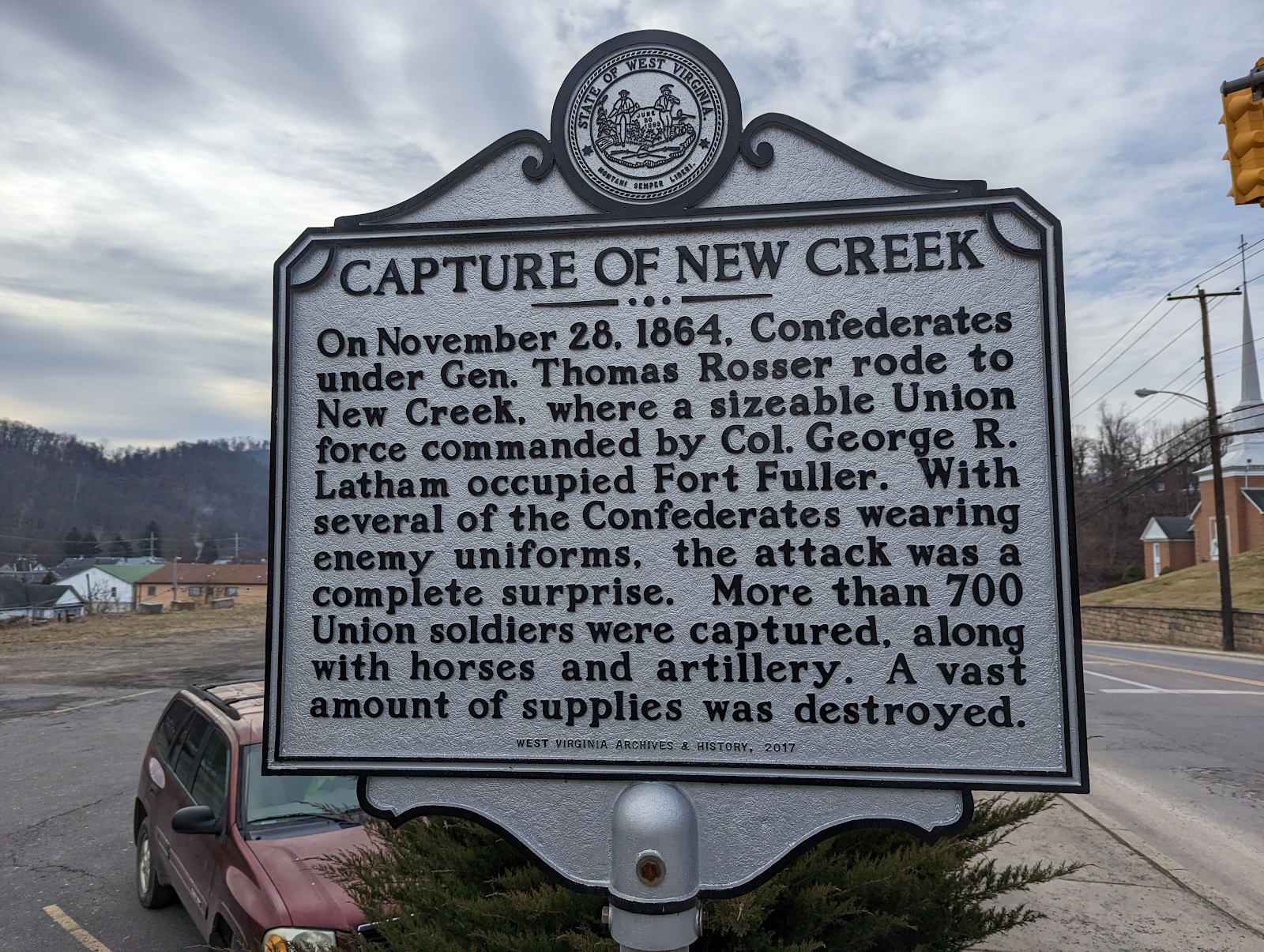Aug. 1, 1864
Battle of Folck's Mill; or more grandiosely (and rarely) known as the Battle of Cumberland
Cumberland, MD (Alleghany County)
Union General Benjamin F. Kelley defends Cumberland (with two infantry units and three "hastily organized civilian volunteer companies"): Ohio National Guard, West Virginia infantry, Illinois Artillery, and 2nd Potomac Home Guard Maryland Infantry; while Union Gen. William W. Averell approaches with 2,000 cavalrymen in pursuit
vs.
Gen. John C. McCausland's lawless raiders (about 2,800 men)
 |
| https://www.hmdb.org/m.asp?m=179238 |
Folck's Mill
Retaliation Rebuffed
—1864 Chambersburg Raid—
During the Civil War, retribution by one side for "atrocities” committed against civilians by the other quickly escalated. Confederate Gen. Jubal A. Early, during his 1864 Maryland invasion, demanded that several towns pay "ransoms" or be torched to avenge Union Gen. David Hunter's destruction of houses in the Shenandoah Valley. After Early returned to Virginia, he ordered Gen. John McCausland north to demand a ransom of Chambersburg, Pa. When Chambersburg residents refused, McCausland burned the town on July 31. The timely arrival of Union troops prevented his burning Hancock, Md., and McCausland retreated to Virginia.
After Confederate forces under Gen. John McCausland burned Chambersburg, Pennsylvania, on July 31, 1864, they began moving back toward the Potomac River. McCausland briefly occupied Hancock, Maryland, but ordered a quick departure when Union Gen. William W. Averell's cavalry command approached. Riding west, with Gen. Bradley T. Johnson's rear guard delaying Averell, McCausland paused briefly about 14 miles east of here at Bevansville to rest his men and horses, then continued west at dawn. The Confederates arrived here the next day, on the afternoon of August 1.
Gen. Benjamin F. Kelley, learning of McCausland's raid and approach to Cumberland, had positioned a blocking force on the hills behind you. His line extended from the hills to your left and along the road behind you to present-day Williams Road. When McCausland deployed his force, his men occupied the high ground on the hill directly in front of you, with skirmishers on the current Hillcrest Cemetery site. Folck's Farm and Mill site was located in the center of the engagement, about where the current entrance ramp from U.S. Rte. 220 joins I-68.
The fight began at about 3 P.M. when the Federals opened fire on McCausland's men. For the next four and a half hours, the shooting continued. McCausland, however, realized that with Averell closing in behind him, he had no choice but to break contact and retreat south. Under cover of darkness, leaving his campfires burning as a decoy, McCausland and his men slipped away southeast toward Oldtown."
 |
Photographed By Bradley Owen, July 31, 2021
|
 |
| The "hill behind you," where Simpson's 156th OH and artillery were located. |
And here's what's left at the site of the mill. No signage and some slight trespassing. 






And then, a few years later (2024) I returned to Cumberland because--among other things-- there are two other historical markers specifically about Folck's Mill outside town on property belonging to the Ali Ghan Shriners. Obviously that wasn't going to stop me. (And there's plenty more about Cumberland elsewhere.)
 |
| https://www.hmdb.org/m.asp?m=19320 |
"Here in Evitts Creek Valley on August 1, 1864, General McCausland's Confederate cavalry, returning after burning Chambersburg, was surprised by General Kelley's Union troops from Cumberland. The Confederates were repulsed and retreated across the Potomac at Oldtown."
The first markers ( by the pizza place) are where the Union was, on the left. Now we are further East.
 |
https://www.hmdb.org/m.asp?m=19328
Folck's Mill Confederate Raid
Late in July 1864, Confederate Gen. John C. McCausland led two cavalry brigades (about 2,800 men) northward into Pennsylvania and Maryland to capture Chambersburg and Cumberland and either collect a ransom or burn the towns. McCausland burned Chambersburg on July 31. The next day, his raiders reached the National Pike and rode toward Cumberland. Union Gen. William W. Averell led 2,000 cavalrymen in pursuit.
Union Gen. Benjamin F. Kelley hurriedly organized Cumberland’s defenses. He positioned a blocking force of two infantry regiments (about 1,000 men) and four artillery pieces east of town on wooded hills overlooking Folck’s Mill. Other units, including three hastily organized civilian volunteer companies, occupied prepared positions elsewhere around the town.
When the first Confederates reached Folck’s Mill, the concealed Federals opened fire. The raiders took shelter in the mill buildings and what is now Hillcrest Cemetery. As the main Confederate force arrived, it deployed on the hill behind the advance body. A sharp fight ensued about 3 p.m. and continued for four and a half hours. With Averell pressing their rear and a solid defense in their front, the Confederates had no choice but to escape south under cover of darkness, leaving campfires burning to deceive the Federals. A difficult night march brought the raiders to Oldtown at dawn. Confederate losses at Cumberland numbered two killed, two wounded, and three taken prisoner, while the Federals suffered twelve wounded.
|

Check out the local coverage:
https://www.whilbr.org/BattleofFolcksMill
https://www.whilbr.org/BattleofFolcksMill/Folck-s-Mill
It can't be THAT small of a battle...it got its own Wikipedia page:
I also recommended the history and pizza at Puccini(a colonial mansion adjacent to the battle and used as a temporary hospital afterwards):
 |
From the Puccini menu
* * *
Meanwhile in West Virginia...I probably should have gotten out of the car for this one, but I'd driven almost 1,000 miles in 36 hours so cut me some slack.
 | https://www.hmdb.org/m.asp?m=138068
Fight at Ramsey's Fort
Ramsey’s Fort was a small Union garrison located on a hill west of Kessler’s Cross Lanes during the Civil War that was named for the commander of the local militia, Capt. J.R. Ramsey. A large number of Confederates with Thurmond’s Partisan Rangers attacked the fort on August 1, 1864, and forced the outnumbered defenders to surrender themselves and the fort's stores. |
|




















Comments
Post a Comment